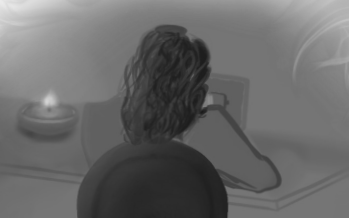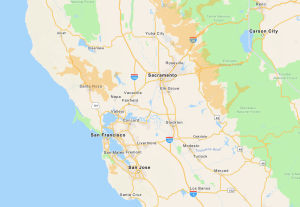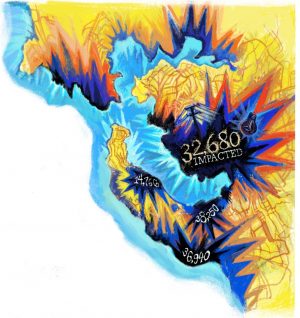Left in the dark
PG&E outages expose disconnect
November 19, 2019
It was a chilly Saturday evening, punctuated only by the shrill cheers of children playing in the yard next door. It was the night before Diwali, and we had just concluded a day of re-organizing the house, embellishing our corners with traditional Indian decorations and placing diyas, mini oil lamps, in every room. My parents had stepped out for a couple hours to run a few last errands, and finally done with my tasks, I sat at my desk and began to do my homework.
In the midst of an annotation, I heard a click. The low buzz of my light fixtures no longer hung in the air, and I was blanketed in darkness and silence. My eyes had yet to adjust to my surroundings, so I sat there for a minute, disconcerted.
Peering outside, everything beyond my window was engulfed in the same shade of black. The sun had since retired to the horizon, but the dark blue sky, just a few shades lighter than the street ahead of me, provided a little light from which I could see our neighbors frantically grabbing flashlights as they made their way to their cars with their suitcases trudging behind them, driving off to a hotel where they would take refuge for the remainder of the power outage.
My story is not unique. I was one of the over 2 million people to be affected by the second round of Pacific Gas and Electric’s (PG&E) Public Safety Power Shutoffs. While it was inconvenient, I understand the company’s motive for taking such extreme measures to prevent a possible wildfire. But in the shutoffs’ aftermath, fires still occurred, and customers suffered nonetheless.
I’m not advocating for less protective measures; these shutoffs may very well have impeded another potential wildfire. Regardless, PG&E desperately requires a shift in its approach to fire prevention. I believe that more government and public oversight, coupled with better communication, is a strong first step.
Over the course of that Saturday, my family and I received 17 texts warning us that our power would potentially be shut off. Without specific details, we clamored the entire day in preparation, unaware of when or if we would lose power.
Second, as a private company, despite its role as a public utilities firm, PG&E’s primary goal is to acquire profit. By allowing members of the community on its board to lobby for the interests of its customers, the entity can more comprehensively understand customers’ needs and adjust. With government oversight, the company will be held responsible for its actions, unable to work solely for its own benefit.
These are just two steps out of many the company can take to mitigate the necessity of shutoffs of this magnitude in the future. However, these first two steps may be enough to allow us to collectively, once again, see the light.
An abridged version of this article was originally published in the pages of the Winged Post on Nov. 18, 2019.


















![“[Building nerf blasters] became this outlet of creativity for me that hasn't been matched by anything else. The process [of] making a build complete to your desire is such a painstakingly difficult process, but I've had to learn from [the skills needed from] soldering to proper painting. There's so many different options for everything, if you think about it, it exists. The best part is [that] if it doesn't exist, you can build it yourself," Ishaan Parate said.](https://harkeraquila.com/wp-content/uploads/2022/08/DSC_8149-900x604.jpg)




![“When I came into high school, I was ready to be a follower. But DECA was a game changer for me. It helped me overcome my fear of public speaking, and it's played such a major role in who I've become today. To be able to successfully lead a chapter of 150 students, an officer team and be one of the upperclassmen I once really admired is something I'm [really] proud of,” Anvitha Tummala ('21) said.](https://harkeraquila.com/wp-content/uploads/2021/07/Screen-Shot-2021-07-25-at-9.50.05-AM-900x594.png)







![“I think getting up in the morning and having a sense of purpose [is exciting]. I think without a certain amount of drive, life is kind of obsolete and mundane, and I think having that every single day is what makes each day unique and kind of makes life exciting,” Neymika Jain (12) said.](https://harkeraquila.com/wp-content/uploads/2017/06/Screen-Shot-2017-06-03-at-4.54.16-PM.png)








![“My slogan is ‘slow feet, don’t eat, and I’m hungry.’ You need to run fast to get where you are–you aren't going to get those championships if you aren't fast,” Angel Cervantes (12) said. “I want to do well in school on my tests and in track and win championships for my team. I live by that, [and] I can do that anywhere: in the classroom or on the field.”](https://harkeraquila.com/wp-content/uploads/2018/06/DSC5146-900x601.jpg)
![“[Volleyball has] taught me how to fall correctly, and another thing it taught is that you don’t have to be the best at something to be good at it. If you just hit the ball in a smart way, then it still scores points and you’re good at it. You could be a background player and still make a much bigger impact on the team than you would think,” Anya Gert (’20) said.](https://harkeraquila.com/wp-content/uploads/2020/06/AnnaGert_JinTuan_HoHPhotoEdited-600x900.jpeg)

![“I'm not nearly there yet, but [my confidence has] definitely been getting better since I was pretty shy and timid coming into Harker my freshman year. I know that there's a lot of people that are really confident in what they do, and I really admire them. Everyone's so driven and that has really pushed me to kind of try to find my own place in high school and be more confident,” Alyssa Huang (’20) said.](https://harkeraquila.com/wp-content/uploads/2020/06/AlyssaHuang_EmilyChen_HoHPhoto-900x749.jpeg)










